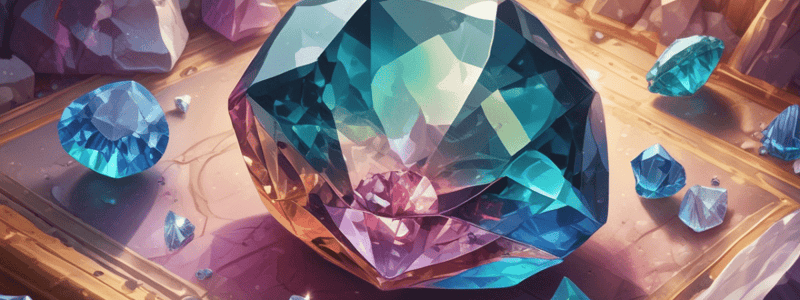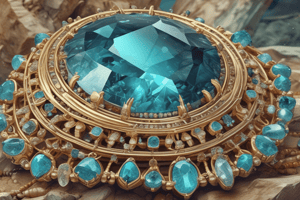Podcast
Questions and Answers
What is the main reason why cutters take less care with inexpensive, low-quality rough?
What is the main reason why cutters take less care with inexpensive, low-quality rough?
- Because it affects the gem's brilliance and color
- Because the market demands precise cutting and proportions in gems
- Because it is easier to cut and polish
- Because it is less valuable and not rare (correct)
What is the term for dark areas in a gemstone?
What is the term for dark areas in a gemstone?
- Color intensity
- Windows
- Extinction (correct)
- Brilliance
Why are proportion variations often seen in colored stones?
Why are proportion variations often seen in colored stones?
- To retain as much weight as possible
- To create a symmetrical cut
- To save weight and reduce cost (correct)
- To increase brilliance and color intensity
What is the main factor at the begin of the cutting process that affects a finished gem's value?
What is the main factor at the begin of the cutting process that affects a finished gem's value?
What type of cut is often used for opaque or translucent rough?
What type of cut is often used for opaque or translucent rough?
What is the effect of deep pavilions on a gemstone?
What is the effect of deep pavilions on a gemstone?
What is the purpose of proportion variations in a gemstone?
What is the purpose of proportion variations in a gemstone?
What is NOT evaluated in a faceted gem to determine its proportions?
What is NOT evaluated in a faceted gem to determine its proportions?
What does expert cutting maximizes in a gemstone?
What does expert cutting maximizes in a gemstone?
What is the primary reason for maximizing a gem's brilliance and color?
What is the primary reason for maximizing a gem's brilliance and color?
What type of gemstones typically have areas of lower color intensity?
What type of gemstones typically have areas of lower color intensity?
Why do cutters use proportion variations in colored stones?
Why do cutters use proportion variations in colored stones?
What is the result of a gemstone with deep pavilions?
What is the result of a gemstone with deep pavilions?
How does preforming cutting process affect a gemstone?
How does preforming cutting process affect a gemstone?
What is the purpose of evaluating a faceted gem's proportions?
What is the purpose of evaluating a faceted gem's proportions?
What is the primary factor that influences a gemstone's interaction with light?
What is the primary factor that influences a gemstone's interaction with light?
What is the term for variations in a gemstone's outline to save weight?
What is the term for variations in a gemstone's outline to save weight?
What is the consequence of a gemstone with uneven brilliance?
What is the consequence of a gemstone with uneven brilliance?
Flashcards are hidden until you start studying
Study Notes
Cutting and Proportions of Faceted Gems
- Expert cutting maximizes a gem's brilliance and color, especially in transparent rough.
- Flat stones with shallow pavilions often have areas of lower color intensity, called windows, and dark areas or extinction through the crown.
- Cutters use proportion variations to retain as much weight as possible in expensive, rare, high-quality rough.
- In contrast, cutters take less care with inexpensive, low-quality rough.
- The market demands precise cutting and proportions in gems cut from relatively available, moderately priced rough.
- Preforming, which has the greatest impact on a finished gem's value, is done by highly skilled workers.
Evaluating Faceted Gems
- Important factors in evaluating a faceted gem's proportions include crown and pavilion depths, symmetry of its profile, and face-up outline.
- Proportion and symmetry variations are visible through the crown as reduced or uneven brilliance.
Cutting Opaque or Translucent Rough
- Opaque or translucent rough is often cut into cabochons, cameos, intaglios, or beads.
Cutting and Proportions of Faceted Gems
- Expert cutting maximizes a gem's brilliance and color, especially in transparent rough.
- Flat stones with shallow pavilions often have areas of lower color intensity, called windows, and dark areas or extinction through the crown.
- Cutters use proportion variations to retain as much weight as possible in expensive, rare, high-quality rough.
- In contrast, cutters take less care with inexpensive, low-quality rough.
- The market demands precise cutting and proportions in gems cut from relatively available, moderately priced rough.
- Preforming, which has the greatest impact on a finished gem's value, is done by highly skilled workers.
Evaluating Faceted Gems
- Important factors in evaluating a faceted gem's proportions include crown and pavilion depths, symmetry of its profile, and face-up outline.
- Proportion and symmetry variations are visible through the crown as reduced or uneven brilliance.
Cutting Opaque or Translucent Rough
- Opaque or translucent rough is often cut into cabochons, cameos, intaglios, or beads.
Studying That Suits You
Use AI to generate personalized quizzes and flashcards to suit your learning preferences.




